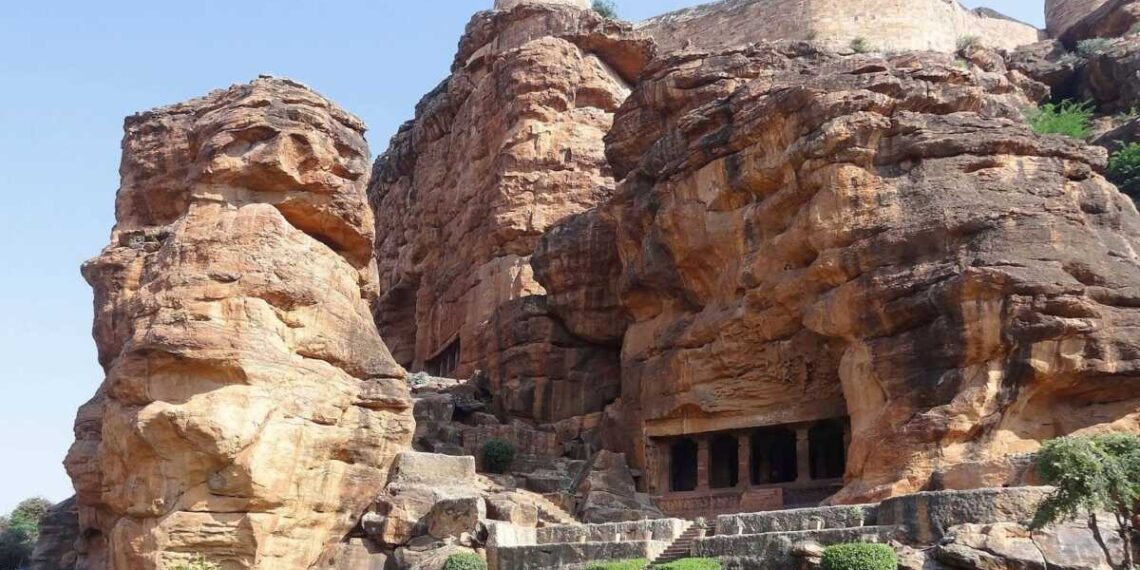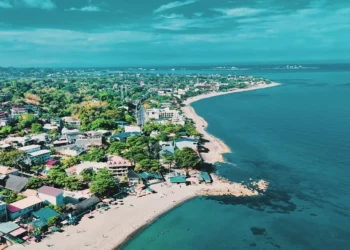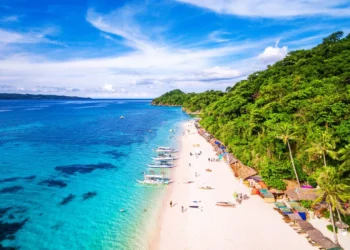The Badami Cave Temples located in Bagalkot district in Karnataka, 35 km from Aihole, is carved into the red cliffs of Badami. The 6th century cave temples show the Chalukya dynasty’s amazing carving skills. Covering a small area, the four main caves are filled with Hindu and Jain carvings and are included on the UNESCO World Heritage list. The cave temples sit above Agastya Lake and the surrounding area was once the Chalukya capital, called Vatapi.
Legend of the Caves
The legend regarding Badami Cave Temples says that the sage Agastya lived here and performed his penance by the lake, which got his name. The caves were made to honor the gods he loved and worshipped. People believe the lake’s water washes away papas(sins). Another tale from the Ramayana and Mahabharata tells of two demons, Vatapi and Ilvala, who tricked travelers until Agastya defeated them, making the land holy for temples.
History of the Badami Cave Temples
The caves started to be built in the 6th century under the Chalukya dynasty, who ruled Vatapi from 540 to 757 CE. King Pulakeshin I made Badami strong in 544 CE, picking its cliffs for safety, as a inscribed on a boulder carving. His sons, Kirtivarman I and Mangalesha, had the caves built, with Cave 3’s writing from 578 CE showing Mangalesha’s work, making it India’s oldest dated Hindu cave temple. Stone notes say Mangalesha gave a village, Lanjisvara (now Nandikesvara), to keep the caves functioning. The Chalukyas, who brought the Deccan together, made Badami a busy place for art and learning, as old books like Ptolemy’s 2nd-century Geography hint.
By the 7th century, Badami was full of life, with traders and craftsmen helping it grow, village records show. Pulakeshin II (610–642 CE) made the kingdom bigger, but the Pallavas attacked in 642 CE, hurting Vatapi for a while. The Vijayanagara kings, from the 14th to 16th centuries, fixed parts and added fort walls. Later, the Adil Shahis, Marathas, and British controlled Badami, with the British taking over the caves by 1856. Now, the Archaeological Survey of India (ASI) looks after them. The caves’ holy history is included in Kannada writings and songs by saints like Basavanna, showing their place in Hindu and Jain faith.
Architecture of the Caves
The Badami Cave Temples, cut from soft red sandstone, mix North India’s Nagara and South India’s Dravida styles, a Chalukya specialty. Each cave has three parts: an open porch with carved pillars, a main hall with more pillars, and a small holy room deep inside. A path with steps joins the caves, giving views of Agastya Lake and Badami’s forts. The caves, numbered 1 to 4, climb the cliff, with Cave 1 about 59 feet up.
Cave 1, for Shiva, is likely the oldest, made around 550 CE. Its porch has a big carving of Shiva as Nataraja with 18 arms, showing 81 dance moves, plus pictures of Ardhanarishvara and Harihara. Pillars have little dwarf figures, and the ceiling shows a snake god. Cave 2, for Vishnu, has a similar setup, with carvings of Varaha saving Bhudevi and Trivikrama stepping across the world. Its pillars have lion-like creatures. Cave 3, the biggest, is for Maha Vishnu, with a 578 CE writing. Its front shows huge carvings of Vishnu on a snake, Narasimha, and Harihara, and the ceiling has faded paintings of gods and people, rare for that time. Cave 4, a Jain cave, has Tirthankara Mahavira sitting calmly, with Parshvanatha and Gomateswara carvings, small but detailed. All caves have gods, spirits, and animals carved in the red-blue stone, showing Chalukya talent.
The caves show a mix of Shiva, Vishnu, and Jain love, proving the Chalukyas welcomed all faiths. Their style helped shape Aihole and Pattadakal temples. An ASI museum nearby holds Chalukya finds, adding to the caves’ story.
Festivals and Rituals
Even though the caves aren’t used for worship now but they get lively during local events. The Chalukya Utsava in February brings folk dances like Dollu Kunitha, Carnatic songs, and plays near the caves, pulling in crowds. The Banashankari Jatra, a January-February fair at the nearby Banashankari Temple, sees people visit the caves for blessings, linking them to Badami’s faith. Long ago, the caves likely had offerings for Shiva, Vishnu, and Tirthankaras, based on their designs. Now, they’re open from 9 AM to 5:30 PM (₹30 for Indians, ₹500 for foreigners), and visitors often see Aihole (35 km) or Pattadakal (23 km) too, making a history trip.
The caves are a big part of Karnataka’s history. Songs by saints like Basavanna, tied to Shiva’s devotion, keep the Bhakti spirit going. The carvings—showing gods, divine couples, and day to day life—hold Chalukya life, like a book in stone. By Agastya Lake, with Bhutanatha Temples across, the caves tie to Karnataka’s past as an art center, alongside Aihole and Pattadakal. They draw people from everywhere, reachable by road from Bengaluru or train from Hubballi (105 km). Many add Hampi (140 km) too to their trip.
Final Thoughts
The Badami Cave Temples are a key piece of Karnataka’s heritage and temple culture. Whether you’re looking for stunning architecture, cultural richness, or simply a place to relax, the Badami Cave Temples is a must to visit in Karnataka where the Chalukyas’ work lives in every stone.











